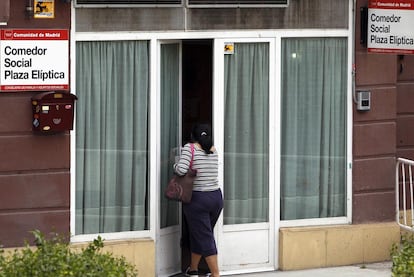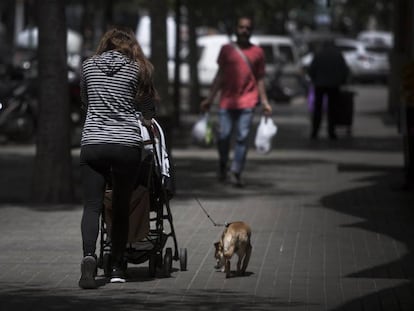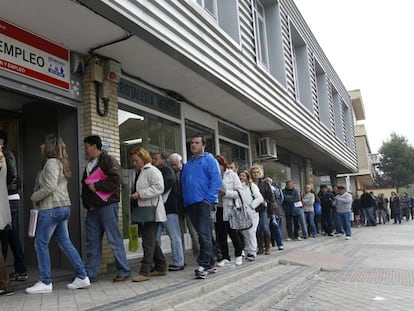Almost 28% of Spanish population at risk of poverty or social exclusion
New survey using 2015 data shows average household income grew 2.4% to €26,730 from previous year

A new report shows that 27.9% of the population in Spain is at risk of slipping into poverty or social exclusion. The figure, which was arrived at by examining declared income from 2015, is slightly better than the 28.6% that was registered using 2014 data, but it is still far from the 26.7% recorded in 2010. At the height of the crisis, in 2013, the percentage of at-risk individuals reached 29.2% of the population.

The data, which was compiled by the National Statistics Institute (INE) in its Living Conditions Survey, show that the? lowest-income households are made up of young, poorly trained, unemployed foreigners (particularly from outside the EU) who are single parents and live in southern Spain, most notably in Andalusia.
That is despite the fact that an improved labor market made the average household income grow 2.4% to €26,730 compared with the previous year. That is still a far cry from the €28,206 registered in 2010. Meanwhile, average per capita income advanced 2.8% to €10,708.
A Madrile?o who earns €18,000 could well have no more purchasing power than an Andalusian who reports earnings of €15,000
However, this does not quite mean that one out of every three Spanish residents, or 13 million people, are poor. The AROPE indicator, which stands for At Risk of Poverty or Social Exclusion, considers the situation of people either at risk of poverty, or severely materially deprived or living in a household with a very low work intensity, according to Eurostat definitions. It is therefore a measure of relative income poverty, and of inequality.
In the EU, people falling below 60% of median income are said to be ¡°at risk of monetary poverty,¡± according to AROPE rules. So in theory all incomes could rise while this ratio remained the same. Being a relative index, it does not undergo drastic changes, even when the economic cycle changes.
Added to the mix are households with low work intensity, meaning those whose members put in less than 20% of the work that they could theoretically contribute, and families with severe material deprivations who meet four of nine criteria: an inability to deal with unexpected expenses, to pay the rent or utility bills in time, to keep their home adequately warm, to go on a one-week vacation once a year, to eat meat, fish or a protein equivalent every second day, or to own and use a car, a washing machine, a TV or a telephone.

The rate does not take into account whether families own their own home, meaning that there is no rent to pay; this makes a significant difference in a country like Spain, where home ownership is extremely high. And the indicator also fails to consider the effect of free public services such as education or health. Nor does it factor in the difference in prices across the regions.
This means that larger countries tend to come out badly, because of greater regional disparities. In Spain, a Madrile?o who earns €18,000 could easily have no more purchasing power than an Andalusian who reports earnings of €15,000, because of the different cost of living.
That is why the best measure of poverty may well be the Severe Material Deprivation indicator, which analyzes households¡¯ financial struggles. And this shows that 39.5% of households were unable to afford a weeklong vacation away from home, that 38.1% were unable to deal with unexpected expenses, that 15.3% had trouble making ends meet at the end of each month, and that 8.4% were late paying their bills. In short, 5.8% of the population, or 2.6 million people, met at least four out of the nine criteria. The figure improves on the 7.1% registered in 2013, but falls significantly short of the 3.6% recorded in 2008.
It bears noting that the 65-and-over age group has weathered the economic crisis better than anyone else, largely thanks to their guaranteed pensions. This is the only group where the risk of falling into poverty has actually dropped: it went from 16.5% in 2011 to 14.4% in 2015.
English version by Susana Urra.
Tu suscripci¨®n se est¨¢ usando en otro dispositivo
?Quieres a?adir otro usuario a tu suscripci¨®n?
Si contin¨²as leyendo en este dispositivo, no se podr¨¢ leer en el otro.
FlechaTu suscripci¨®n se est¨¢ usando en otro dispositivo y solo puedes acceder a EL PA?S desde un dispositivo a la vez.
Si quieres compartir tu cuenta, cambia tu suscripci¨®n a la modalidad Premium, as¨ª podr¨¢s a?adir otro usuario. Cada uno acceder¨¢ con su propia cuenta de email, lo que os permitir¨¢ personalizar vuestra experiencia en EL PA?S.
En el caso de no saber qui¨¦n est¨¢ usando tu cuenta, te recomendamos cambiar tu contrase?a aqu¨ª.
Si decides continuar compartiendo tu cuenta, este mensaje se mostrar¨¢ en tu dispositivo y en el de la otra persona que est¨¢ usando tu cuenta de forma indefinida, afectando a tu experiencia de lectura. Puedes consultar aqu¨ª los t¨¦rminos y condiciones de la suscripci¨®n digital.










































